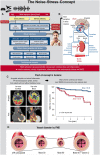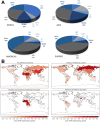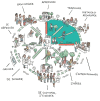Environmental risk factors and cardiovascular diseases: a comprehensive expert review
- PMID: 34609502
- PMCID: PMC9648835
- DOI: 10.1093/cvr/cvab316
Environmental risk factors and cardiovascular diseases: a comprehensive expert review
Abstract
Non-communicable diseases (NCDs) are fatal for more than 38 million people each year and are thus the main contributors to the global burden of disease accounting for 70% of mortality. The majority of these deaths are caused by cardiovascular disease (CVD). The risk of NCDs is strongly associated with exposure to environmental stressors such as pollutants in the air, noise exposure, artificial light at night, and climate change, including heat extremes, desert storms, and wildfires. In addition to the traditional risk factors for CVD such as diabetes, arterial hypertension, smoking, hypercholesterolaemia, and genetic predisposition, there is a growing body of evidence showing that physicochemical factors in the environment contribute significantly to the high NCD numbers. Furthermore, urbanization is associated with accumulation and intensification of these stressors. This comprehensive expert review will summarize the epidemiology and pathophysiology of environmental stressors with a focus on cardiovascular NCDs. We will also discuss solutions and mitigation measures to lower the impact of environmental risk factors with focus on CVD.
Keywords: Air pollution; Cardiovascular disease; Cardiovascular risk factors; Environmental stressors; Heat; Light pollution; Noise; Oxidative stress.
© The Author(s) 2021. Published by Oxford University Press on behalf of the European Society of Cardiology.
Conflict of interest statement
Conflict of interest: none declared.
Figures








Similar articles
-
The "exposome" concept - how environmental risk factors influence cardiovascular health.Acta Biochim Pol. 2019 Sep 10;66(3):269-283. doi: 10.18388/abp.2019_2853. Acta Biochim Pol. 2019. PMID: 31509369 Review.
-
Environmental Factors Such as Noise and Air Pollution and Vascular Disease.Antioxid Redox Signal. 2020 Sep 20;33(9):581-601. doi: 10.1089/ars.2020.8090. Epub 2020 May 7. Antioxid Redox Signal. 2020. PMID: 32245334 Review.
-
The macroeconomic burden of noncommunicable diseases associated with air pollution in China.PLoS One. 2019 Apr 18;14(4):e0215663. doi: 10.1371/journal.pone.0215663. eCollection 2019. PLoS One. 2019. PMID: 30998763 Free PMC article.
-
Integrated screening and treatment services for HIV, hypertension and diabetes in Kenya: assessing the epidemiological impact and cost-effectiveness from a national and regional perspective.J Int AIDS Soc. 2020 Jun;23 Suppl 1(Suppl 1):e25499. doi: 10.1002/jia2.25499. J Int AIDS Soc. 2020. PMID: 32562353 Free PMC article.
-
Health system costs for individual and comorbid noncommunicable diseases: An analysis of publicly funded health events from New Zealand.PLoS Med. 2019 Jan 8;16(1):e1002716. doi: 10.1371/journal.pmed.1002716. eCollection 2019 Jan. PLoS Med. 2019. PMID: 30620729 Free PMC article.
Cited by
-
Nutritional status, health risk behaviors, and eating habits are correlated with physical activity and exercise of brazilian older hypertensive adults: a cross-sectional study.BMC Public Health. 2022 Dec 19;22(1):2382. doi: 10.1186/s12889-022-14873-4. BMC Public Health. 2022. PMID: 36536331 Free PMC article.
-
Impact of objectively-measured sleep duration on cardiometabolic health: A systematic review of recent evidence.Front Endocrinol (Lausanne). 2022 Dec 19;13:1064969. doi: 10.3389/fendo.2022.1064969. eCollection 2022. Front Endocrinol (Lausanne). 2022. PMID: 36601010 Free PMC article. Review.
-
Climate and human health: a review of publication trends in the International Journal of Biometeorology.Int J Biometeorol. 2023 Jun;67(6):933-955. doi: 10.1007/s00484-023-02466-8. Epub 2023 May 2. Int J Biometeorol. 2023. PMID: 37129619 Free PMC article. Review.
-
Tele-Medical Nutrition Therapy to Promote Healthy Eating and Nutrition Adherence of Chronic Patients in the COVID-19 Pandemic: A Pragmatically Before-After Trial.Health Sci Rep. 2024 Nov 13;7(11):e70193. doi: 10.1002/hsr2.70193. eCollection 2024 Nov. Health Sci Rep. 2024. PMID: 39540025 Free PMC article.
-
Impact of Indoor Air Pollutants on the Cardiovascular Health Outcomes of Older Adults: Systematic Review.Clin Interv Aging. 2024 Oct 1;19:1629-1639. doi: 10.2147/CIA.S480054. eCollection 2024. Clin Interv Aging. 2024. PMID: 39372166 Free PMC article. Review.
References
-
- GBD 2016 Disease and Injury Incidence and Prevalence Collaborators . Global, regional, and national incidence, prevalence, and years lived with disability for 328 diseases and injuries for 195 countries, 1990-2016: a systematic analysis for the Global Burden of Disease Study 2016. Lancet 2017;390:1211–1259. - PMC - PubMed
-
- World Health Organization . Noncommunicable diseases: Mortality. https://www.who.int/gho/ncd/mortality_morbidity/en/ (13 October 2021, date last accessed).
-
- Bygbjerg IC. Double burden of noncommunicable and infectious diseases in developing countries. Science 2012;337:1499–1501. - PubMed
Publication types
MeSH terms
LinkOut - more resources
Full Text Sources
Medical

